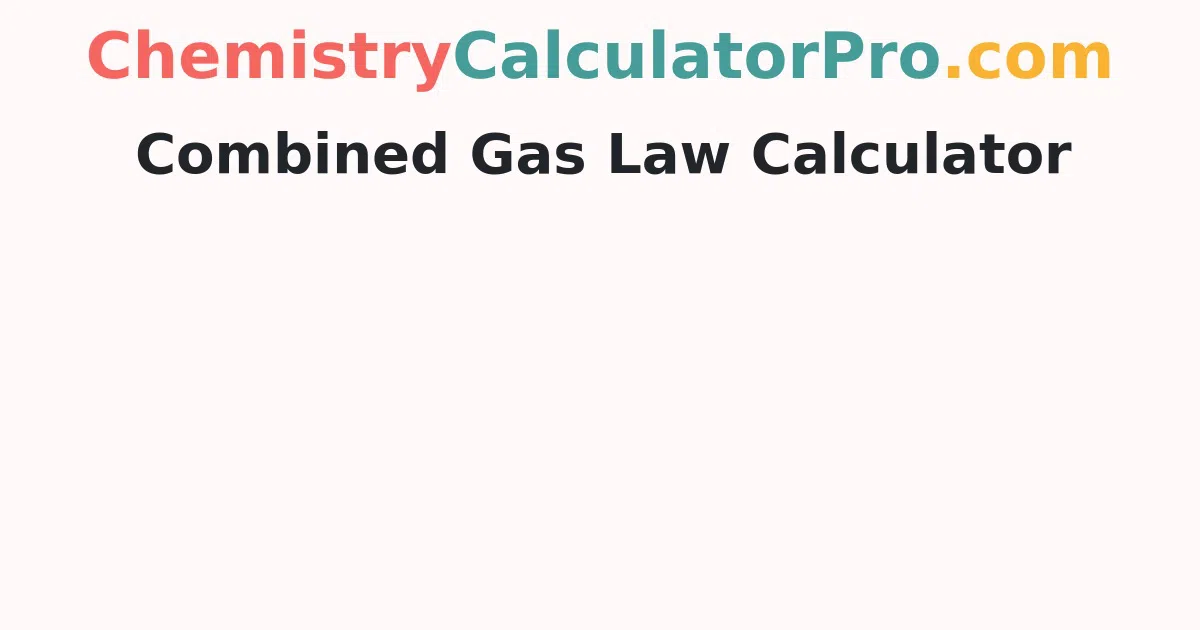Combined Gas Law Calculator
Combined Gas Law Calculator is an online tool that displays the unknown temperature, volume or pressure using combined gas law equation in a matter of seconds. All you have to do is simply enter the inputs and click on the calculate button to get respective output.
What is a perfect gas?
A combined gas is a subset of any gas that meets the following requirements:
- The gas is made up of many molecules that move about at random.
- Every molecule is a point particle.
- Except for colliding, the molecules do not interact.
- All collisions among gas particles are entirely elastomeric.
- Newton's laws of motion apply to the particles.
Combined Gas Law Definition & Formula
Boyle's law, Charles law, and Gay-law Lussac's combine to form combined gas law in chemistry. Temperature, pressure, and volume are all related to this law. The combined gas law states the ratio of the products of compression and expansion to temperature. The system is kept constant in this situation. The mathematical expression for the mixed gas law is
K = PV/T
- Where, K stands for constant
- P is the Pressure, V is the Volume and T is the Temperature
- R is the Gas Constant and its value is approximately equal to 8.3145 joules per kelvin per mole (J · K-1 · mol-1)
How to Use Combined Gas Law Calculator?
Follow the simple steps listed below to use the Combined Gas Law Calculator tool. They are along the lines
- In the input area, enter the pressures, temperatures, quantity, and x for the unknown variable.
- To have the unknown concentration, click the "Evaluate x" button.
- Enter the input mass of the substance.
- Eventually, utilising the combined gas law, the undetermined variable such as temperature, pressures, or volumes will be shown in the outputs field.
Combined Gas Law Examples
Example 1:
At 20.00 °C, a sealed jar with a volume of exactly 1 litre contains exactly 1 mole of air. What is the pressure inside the jar in pascals if the air behaves like an ideal gas? Leave a comment on your response.
Solution:
We Use the ideal gas equation, PV = nRT, to solve.
Rearrange the equation so that the subject is P i.e. nRT / V = P
Using the correct SI units, write down the known values i.e. n = 1 R = 8.314 J · K-1 · mol-13P = (1 × 8.314 × 293.15) / 0.001
P = 2,437,249
P = 2.437 × 106 Pa
FAQ’s on Combined Gas Law Calculator
1. What is the difference between p1 v1 and p2 v2?
P1V1 = P2V2 is the connection for Boyle's Law, where P1 and V1 are the initial pressures and volumes values, and P2 and V2 are the pressures and volumes of the gas after modification.
2. What is the relationship between the combined gas law and other laws?
Charles' Law, Boyle's Law, and Gay-Law Lussac's are integrated into the combined gas law. According to this formula, the proportion of the product of compression and expansion to the actual temperature of a gas is equal to unity. The combined gas law is obtained by adding Avogadro's law to it.
3. What are some instances of how the combined gas law is applied in practice?
In everyday situations, the combined gas law has applications. This rule applies whenever the amount of gas remains constant, but the pressures, density, and temperatures fluctuate. Cloud formation, freezers, and air conditioning units, for example, are all predicted by the law.
4. Do units count when it comes to the combined gas law?
The constant, k, will change depending on the amount of moles in the system. k will be a real constant value as long as the number of moles remains constant. For pressure and volume, any units will suffice, but the temperature must be absolute (Kelvin).
